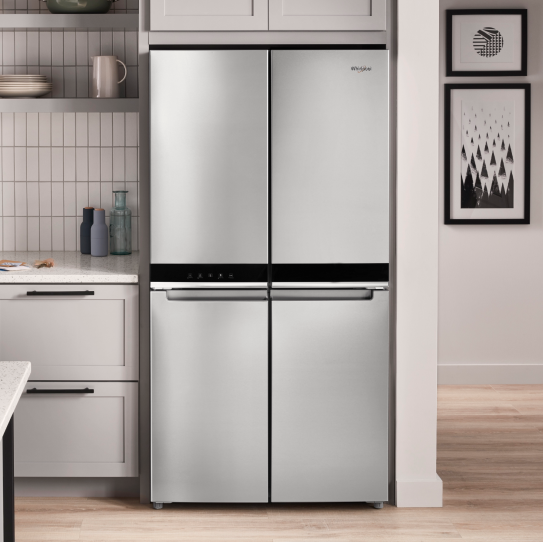
What is freezer burn, and how can you prevent it?
Freezer burn is bound to strike your frozen foods every once in a while, but learning what to look for, how to handle it and methods to help prevent freezer burn can help keep it at bay. Select a topic below or read on to learn more about identifying, managing and preventing freezer burn from settling into your family’s favorites.
What is freezer burn?
Freezer burn happens when frozen foods are exposed to cold, dry air, which causes them to dehydrate as the outer layers lose moisture. One of the most commonly recognized signs of freezer burn is the formation of ice crystals on the outside of food, making it appear frost bitten. Freezer burn is safe to eat, but will often dramatically impact the flavor and texture of the affected food.
What causes freezer burn?
Improper packaging or temperature, and sometimes too long in the freezer, are the most common culprits that lead to freezer burn. Cold, dry air is more likely to permeate foods that aren’t tightly wrapped, left open or stored in frequently fluctuating temperatures. This leads to dried out sections that can affect the look, taste and texture of meats, produce and other frozen products.
According to the USDA, food stored at 0°F will always be safe to eat, but it may not be an appetizing experience. To keep your favorite foods looking and tasting great, read these tips on how to identify and help prevent freezer burn on meat, vegetables and other essentials.


Can you eat freezer-burned foods?
You’re likely to notice a shift in flavor or texture that makes freezer-burned food less appealing. Storing food for shorter durations will help you avoid the altered texture and taste brought on by freezer burn. Learn more about how to defrost frozen foods, how long meats should be kept frozen, and find out the best refrigerator temperatures and freezer temperatures to avoid spoiling.
What does freezer burn look like?
Freezer burn can look slightly different from food group to food group, but some indicators are consistent across the board. Most freezer burned food will develop ice crystals and its coloration may change, giving it an overall dull appearance. Meats often take on a gray-brown color and may look tough or leathery, while fruits and vegetables are visibly dry and shriveled. Starchy foods like baked goods and cooked grains tend to develop a rougher texture and ice cream’s milky consistency is covered with a coat of ice crystals.
What does freezer burn taste like?
Freezer burn noticeably affects the flavor and texture of food, resulting in dishes that taste unusually dry and bland. Your freezer-burned meats and vegetables may feel tougher to chew due to the loss of moisture, and you’re likely to notice a grittier texture from freezer-burned ice cream as a result of accumulated ice crystals.
Can I get rid of freezer burn taste?
It’s not possible to reverse freezer burn, but you may be able to minimize its impact with a few basic practices. If you can, trim away visibly freezer-burned portions of meats prior to cooking and add flavor by marinating or seasoning dishes to taste. For ice cream, try removing the freezer-burned layer to expose the less affected ice cream below. Salvaging the flavor of freezer-burned fruit is easiest when it’s used in a smoothie or rinsed and dehydrated, while your best bet for vegetables is a quick rinse to remove ice crystals and a fair amount of seasoning to assist with flavor.

Need help finding your next refrigerator?


How can I prevent freezer burn?
Reversing the effects of freezer burn may not be possible, but there’s plenty you can do to help prevent it from ever settling into your family’s favorite dishes. To keep foods looking and tasting great, read these tips on how to help prevent freezer burn on meat, vegetables and other essentials.
Step 1: Prepare your food for freezing
Allowing foods to cool properly before freezing can go a long way in preventing freezer burn. Storing hot foods in the freezer may raise the temperature of the freezer compartment, causing the surrounding food to partially thaw before refreezing and increasing the likelihood of freezer burn setting in.
When cooling foods like soups, stews and meats, The United States Department of Agriculture recommends quick cooling to avoid the risk of pathogens that lead to foodborne illness. Generally, it’s best to cool foods to 70 °F within two hours of cooking or 41 °F within four hours. You can do this by allowing foods to cool uncovered in the refrigerator, or setting food inside containers into an ice bath. Be careful to avoid allowing water and ice from the ice bath to mix with the food inside the container.
To prepare fruits and vegetables for freezing, blanch them by boiling them briefly, then draining them and submerging them in ice water. Dry them thoroughly before storing. This helps fruits and vegetables maintain their nutritional value and stops enzymes that would lead to spoiling.
Since the cause of freezer burn is exposure to cold, dry air, it’s important to do all you can to keep food sealed tight. Read on to learn more about packaging food for freezing.
Step 2: Use airtight storage containers
After you’ve prepared your food for freezing, you’ll need to place it in the proper containers to protect it from accidental exposure. Depending on your budget and the type of food, you can use freezer bags, freezer-ready plastic containers, freezer-safe glass or a sealed vacuum bag.
When freezing meat, preventing freezer burn starts with wrapping it in multiple layers of plastic wrap, wax paper or tin foil. Place your items into your preferred container and pack them down to help prevent excess air exposure. If you are using a bag, try to eliminate as much air from it as possible.
Step 3: Set freezers to the proper temperature
Keeping your freezer at the proper temperature can help reduce freezer burn by allowing foods to freeze faster, which produces smaller ice crystals that are less likely to contribute to freezer burn. Preventing freezer burn is a priority, but that doesn’t mean you should risk food spoilage. Whenever you freeze food, make sure that your freezer is set to the proper temperature – zero or below and get to know the parts of your freezer to be able to troubleshoot any problems.
While it’s tempting to think that a warmer freezer will help keep food from getting freezer burn, setting a freezer at a higher temperature could put food into a “danger zone” where it will be at risk of bacteria or mold contamination. Don’t chance it! Learn more tips for finding the right freezer temperature in this comprehensive guide.
Step 4: Limit the amount of time your freezer is open
Keeping your freezer door open too long can cause the compartment’s temperature to fluctuate, increasing ice crystal formation that leads to freezer burn. Be sure to close the freezer door quickly after grabbing your favorite foods. After a grocery trip, consider unloading your new freezer items in one centralized location close to the freezer before storing them to decrease the amount of times the door is opened and closed. Keeping your freezer well organized may also help reduce the amount of time the freezer door stays open.
Step 5: Rotate your foods to help prevent freezer burn
While there are plenty of ways to help prevent freezer burn in the short term, the fact of the matter is that all foods will eventually succumb if left in the freezer too long. That’s why it’s important to rotate food frequently and label all containers with the date that a food was frozen. That will make it easier to eat everything before freezer burn sets in.
Step 6: Avoid thawing and refreezing food
Thawing food causes some moisture loss, so refreezing it may make it more prone to freezer burn. To avoid the need to thaw and refreeze foods, try freezing them in smaller portions so you’re less likely to have leftovers. You can also keep an eye on how long frozen items are left out of the freezer to prevent too much fluctuation in their temperature.

Whirlpool® 4 Door Refrigerators
Flexibility for the whole family
Flexible organization spaces make it easy to store your family’s favorites, from frozen meals to healthy snacks


Explore Whirlpool® Refrigerators and Freezers
Following the steps above can help prevent freezer burn, but you can also lean on useful refrigerator and freezer features to make food storage easier. Features like tiered freezer storage or the door ajar alarm on Whirlpool® Refrigerators can help you keep your freezer organized and alert you when the door is open for too long. Whirlpool® Chest and Upright Freezers even offer features like Fast Freeze and a temperature alarm, allowing you to cool foods quickly and stay in the know about your freezer’s temperature conditions. You can also purchase garage-ready chest and upright freezers to help keep your food fresh without taking up too much space in the kitchen.


Helping kids stay in school
Learn how Whirlpool helps end the dropout cycle by giving kids access to clean clothes through the Care Counts™ Laundry Program
Was this article helpful? Pass it on
Explore more from Whirlpool brand


home heartbeat
Ready for more tips, home hacks and appliance guides?

